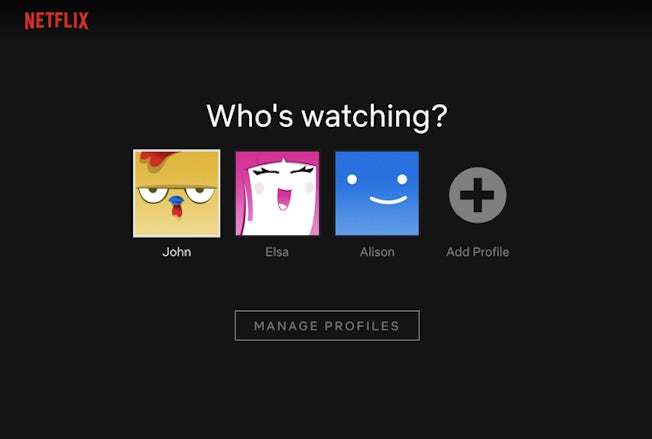For some of the biggest and most considered products and services, the decision to buy doesn’t always come down to a solo customer.
From finance and utilities, to travel, household goods, and entertainment, we often buy (and use) products and services as a couple, family unit, or group of friends.
Why then do many of the online systems we use treat customers as solo decision-makers, tying customer accounts to an individual email address and neglecting (or even discouraging) sharing and collaboration?
Sharing is caring: the brands doing it right
Before I delve into today’s issues and challenges around shared digital experiences, I should acknowledge that there are in fact a few businesses that get this right.
In the digital entertainment world, the likes of Netflix, Apple, and Spotify realised pretty early on that they needed to create a digital equivalent of the stack of shared DVDs and CDs you’d once find in any household.
Not only do these brands let people save money by having ‘family’ plans, but each person in the plan can still keep a personal list of favourite content, so personalised recommendations can still work well enough.

Spotify has gone a step further, recognising that listening to music is often a shared experience. It now offers a ‘Family Mix’, allowing families to collaborate on a shared playlist with songs that cater to everyone.
When it comes to coordinating travel and going out, Airbnb and Opentable both allow you to invite others to ‘join’ a booking you’ve made, and, in the case of Airbnb, collaborate on a plan for each day of your trip.

Similarly, both Airbnb and Amazon let you create shared wishlists, so a family or group of friends can easily plan a booking or purchase together.
What’s more, all of this can happen without people having to share their login with anyone else – an important consideration as today’s customers become more conscious of privacy and security issues.
At the same time, these brands are getting access to more customer data, which means (a) a larger potential audience to market to and (b) a deeper understanding of individual customer preferences (and thus opportunities for personalisation), compared to lumping everything under one account.
The case for shared customer experiences
Whilst a few online players are great at enabling a shared user experience, others are stuck in a more traditional model.
With a growing online grocery sector, and a flurry of subscription-based services delivering anything from wine to coffee, the chore of dragging your trolley through a shop could soon be a thing of the past.
But while most supermarkets offer ‘household accounts’ for pooling together loyalty points, none of the major grocers lets members of a household collaborate around putting together a shopping list for the next delivery, or marking when something has run out.
This means that either an individual has to share their login details across a household, or that the job of grocery shopping needlessly falls to a single person.
Same goes for most utilities and financial service providers. Even if your energy provider lets you name an additional person on the bill, it’s often hard or impossible for that person to create an online account that lets them view and pay their share of the bill online.
And this pain extends a lot further than the task of splitting bills amongst flatmates. Research by Lloyds Bank has revealed that almost half of us actively avoid discussing money, even with our loved ones. But letting partners get a clear picture of their household’s finances could help allay concerns, or at least nudge people towards having the right conversations.
You’d think things might be better when it comes to online tools that help you plan a big decision, such as buying a car or a house, but that’s still not the case. Take Zoopla’s ‘Travel time search’ tool, for example, which only lets you find properties within a commutable distance from one location – something that’s clearly not helpful when two or more people in a household need to commute to work.

How to identify shared CX needs
So if you’re now convinced that your digital product may need to support shared customer experiences, where should you start?
A good place to discover use cases for sharing is the user research you should already be running with your current and prospective customers. Rather than narrowly focusing the research on the use of your product, ask your customers questions like:
- Who else gets involved in this decision? Who might you need to show this to, in order to agree on what to buy/sign up for?
- Do you ever use this website/app with someone else sitting next to you? Why?
- Do you sometimes send links from this website to someone else, or copy some text or take a screenshot in order to share it with others?
For complex decisions, it may make sense during your user research to interview not only the ‘primary decision maker’, but also any additional people taking part in the decision, so that you understand the full context.
This can help you figure out whether one or more of the following customer needs are relevant for your product:
- Shared content, individual views: where multiple people have access to the same ‘library’ of content, but can have their own lists of ‘favourites’ or personalised recommendations (example: a video streaming site like Netflix)
- Shared content, limited rights: where multiple people can be invited to access the same content, but certain rights e.g. making changes or purchases are limited to a ‘primary’ user (example: an online supermarket could let everyone within a family add to the weekly shop, but only a primary user could check out and pay)
- Shared decision making: where multiple people can vote/approve to help pick an option or make a final decision (example: an online travel agent could create a shortlist of potential holiday packages for a group of friends, who could then vote to pick their favourite from that list)
- Shared billing: where the cost of a purchase or a service is split amongst a group of people, before or after the purchase is complete (example: an electricity company could collect individual payments from a group of people sharing a house)
Even if you’re not prepared to radically change how your product works to support sharing, there are a couple of things to check to make sure you’re not actively discouraging sharing:
- The text and images on your website or app should be big enough so that two or more people can easily view them when they’re sitting side by side, sharing a device
- Links copied and pasted from your website should work when shared with others – especially for dynamically-generated pages like search results
- You can encourage people to use email or social sharing by promoting it appropriately (for example, Tiffany’s email sharing feature is aptly named ‘Drop a hint’)

Of course, sharing isn’t entirely risk-free, and before you reap the benefits of including this in your website or app, you should also consider some of the pitfalls:
- Human relationships don’t always fit within a standard mould, and don’t stay constant. If you’re building a product that supports ‘family sharing’, for example, you can’t assume that a ‘family’ includes two adults.
- Even in a shared environment, you’ll probably want to allow people to keep a few things private. Imagine a household having joint access to view all orders from an online department store. Without a means of keeping some things private, it’s a recipe for ruining a surprise gift.
- Finally, if you’re offering special pricing or benefits for people in a ‘shared’ or ‘family’ plan, you’ll need to balance the improved customer experience against the risk of abuse, as brands like Spotify have had to find out recently.
The more the merrier
With everything in our lives transitioning to being managed online, it’s about time that the websites and apps we use start to recognise the nuances of how humans live, play, and make decisions together.
Funnily enough, shared CX is one of those few areas where the B2B world has much to teach the world of B2C and D2C, with many business-focused tools having long catered to sharing and collaboration features.
In over-saturated markets where competitors struggle to differentiate, those brands that take shared customer experiences seriously, and design them into the core of their online products, might just have the means to stand out.







